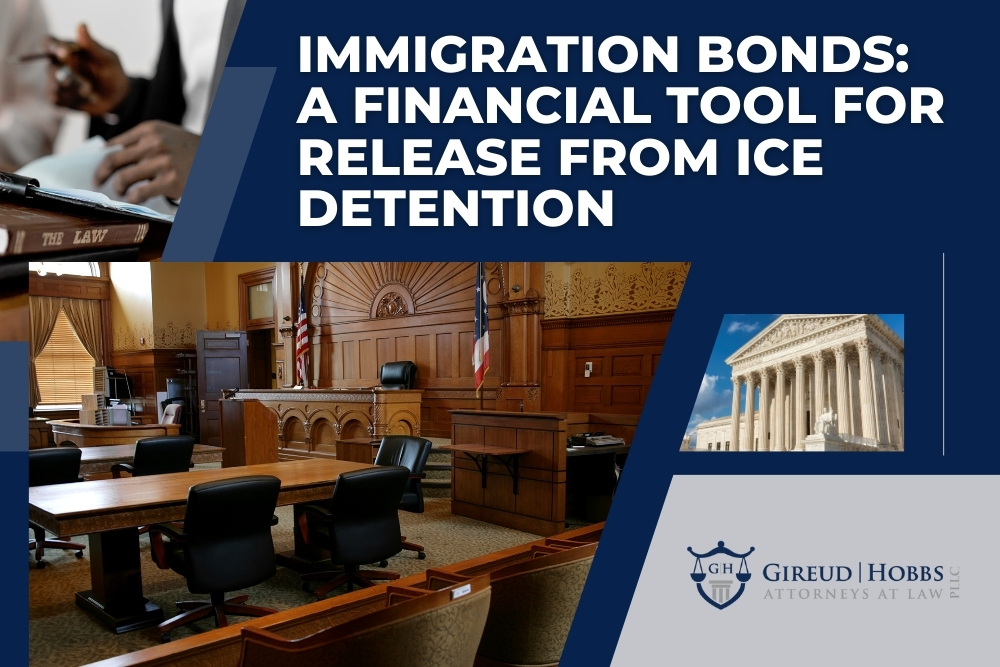When a non-citizen is detained by United States Immigration and Customs Enforcement (ICE), they may be eligible for release from custody through the payment of an immigration bond. Learn how an immigration lawyer can help with immigration bonds and get you or your loved ones released from detention.
Table of Contents
Request A Free Consultation Today!
Request A Free Consultation Today!
What Are Immigration Bonds?
Immigration bonds are a financial tool that allows an individual to leave detention with the condition that they appear for all required immigration court proceedings while their case is pending.
A sum of money is paid to the U.S. government as a guarantee. If the individual fails to appear, the bond is forfeited.
If they comply with all requirements, the bond may be refunded at the conclusion of the case, although this process can take time.

Types of Immigration Bonds
There are two main types of immigration bonds:
- Delivery Bond – This is the most common type. It allows the detained person to be released while they await immigration court proceedings. ICE issues a Notice to Appear (NTA), and a bond amount is set. The bond functions as a promise that the individual will attend their hearings.
- Voluntary Departure Bond – This type of bond applies when a detainee agrees to leave the country voluntarily by a specified date. The bond is refundable if the person departs as agreed but is forfeited if they fail to do so.
Eligibility for Immigration Bonds
Not every person in ICE custody is eligible for an immigration bond. Eligibility is typically determined by ICE or an immigration judge and is based on several factors, including:
- Criminal history
- Immigration violations
- Flight risk
- National security concerns
- Risk to public safety
Individuals with certain serious criminal convictions or prior deportation orders may be subject to mandatory detention and ineligible for a bond. Those who are eligible can request a bond hearing to determine or challenge the bond amount.
How Bond Amounts Are Set
Bond amounts are generally set by ICE officers or, upon request, by immigration judges. There is no fixed amount, but common delivery bond amounts range from $1,500 to over $10,000.
Factors influencing the amount include the person’s ties to the community, history of appearances at court, employment, and the perceived risk that they may not return for future hearings.
Request A Free Consultation Today!
Paying Immigration Bonds
There are two primary ways to pay immigration bonds:
- Cash Bond – A family member, friend, or sponsor pays the full bond amount directly to ICE. This payment must be made by a U.S. citizen or lawful permanent resident. If the individual complies with all conditions, the bond can be refunded after the case concludes, though this may take months or years.
- Surety Bond – This option involves working with a bond company that charges a non-refundable fee (usually 15–20% of the bond amount) to post the bond on behalf of the detainee. The company assumes financial responsibility for the detainee’s compliance with immigration proceedings.

ICE has a dedicated online portal for posting bonds. Your immigration attorney can help you navigate this process.
What Happens After the Bond Is Paid
Once the bond is paid and processed, ICE releases the individual from custody. The person is then expected to attend all scheduled immigration court hearings and comply with court instructions.
The bond remains in effect until the case concludes or until the individual voluntarily departs under the terms of a voluntary departure bond. Failure to appear at hearings or comply with orders will result in the bond being forfeited. In such cases, ICE may also issue a new detention order.
Refunding the Bond
For cash bonds, the full amount may be refunded after the individual’s case ends, as long as they attended all hearings and followed court instructions. The person who posted the bond receives a Form I-391 (Notice of Immigration Bond Canceled), which starts the refund process. However, refunds are not immediate and can take significant time to process.
Bond Hearings and Legal Process
If ICE sets a bond amount that is considered too high, or if the bond is denied, the detainee or their representative can request a bond hearing before an immigration judge. During this hearing, the judge will assess the detainee’s eligibility and may reduce, increase, or deny bond based on the evidence presented. Bond hearings are separate from the main immigration case and usually occur early in the detention process.
Do You Need Legal Help with An Immigration Bond?
Immigration bonds are a key part of the U.S. immigration detention and release system. They allow certain non-citizens to await their immigration hearings outside of detention while providing the government with assurance that individuals will meet their legal obligations.
Understanding the types of immigration bonds, how they are paid, and who is eligible can help families and individuals better navigate a complex and often stressful process. If you or someone you know needs a bond, call us today and schedule a consultation with one of our attorneys. Our experienced immigration lawyers are here to help.

